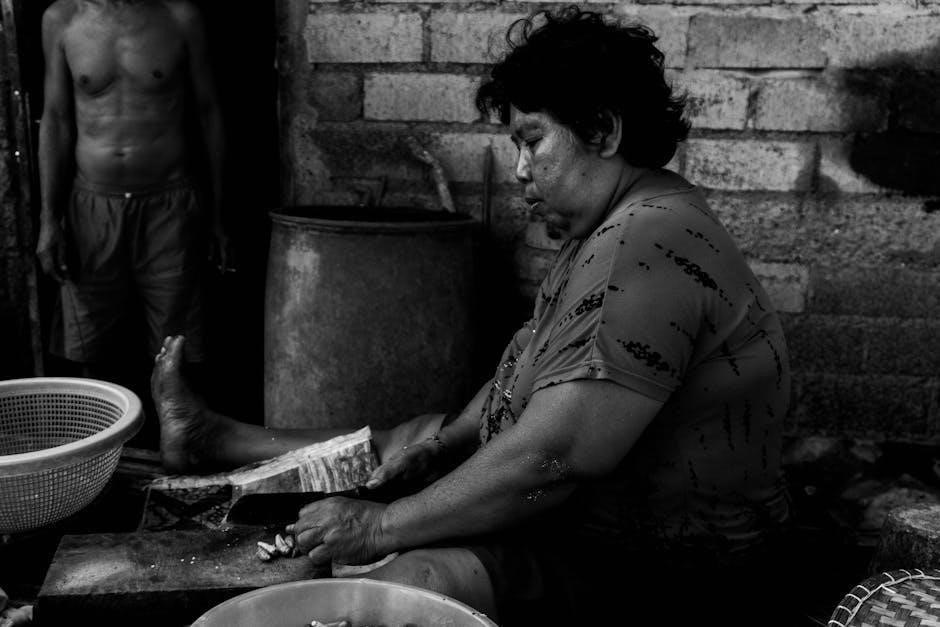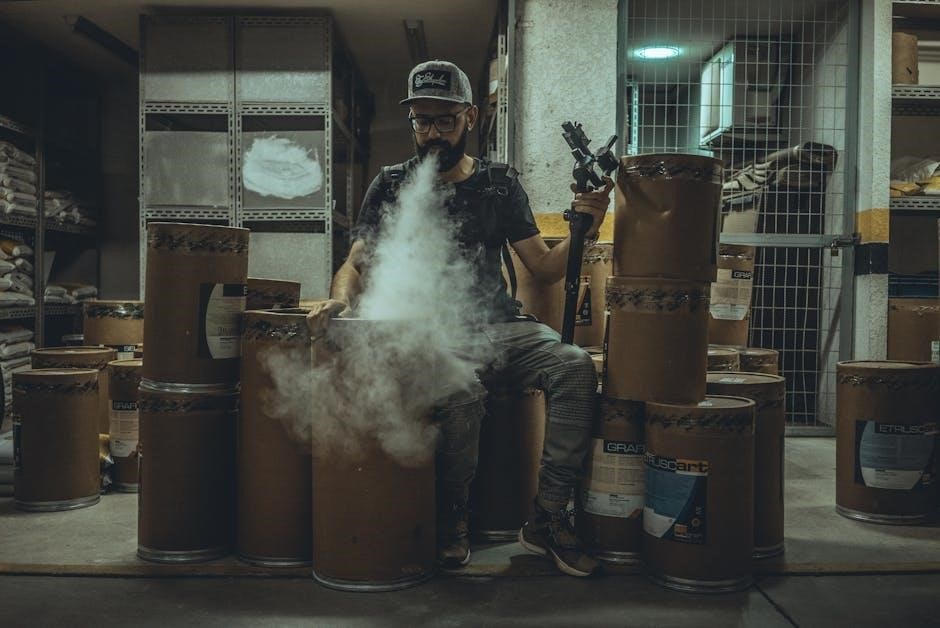A drum smoker‚ often called an Ugly Drum Smoker (UDS)‚ is a cost-effective‚ DIY project that transforms a 55-gallon drum into a smoker․ It offers excellent smoke flavor and temperature control‚ making it ideal for barbecue enthusiasts․ By adding air intakes‚ exhaust systems‚ and cooking grates‚ you can create a functional smoker for delicious results․ This guide provides detailed plans and tips for building and optimizing your drum smoker․
What is a Drum Smoker?
A drum smoker is a DIY barbecue appliance made by converting a 55-gallon steel drum into a smoker․ It involves modifying the drum to include features like air intakes‚ exhaust vents‚ and cooking grates․ This setup allows for controlled smoking of meats‚ providing a cost-effective and customizable alternative to commercial smokers․ The drum’s metal construction helps retain heat‚ enabling consistent smoking temperatures․ By repurposing a drum‚ enthusiasts can create a functional smoker that offers unique flavor profiles and temperature control‚ making it a popular project among those passionate about barbecue and cooking․

Benefits of Using a 55-Gallon Drum for Smoking
Using a 55-gallon drum for smoking offers cost-effectiveness‚ durability‚ and excellent heat retention․ The drum’s large capacity allows for smoking multiple meats at once‚ while its metal construction ensures even heat distribution․ It is a sustainable and customizable option‚ providing a unique smoky flavor that enhances barbecue results․ This DIY approach saves money and offers long-term value․
Materials and Tools Needed
A 55-gallon drum‚ metal saw‚ drill‚ hole saw‚ cooking grate‚ fire basket‚ and weather-resistant sealant are essential․ Additional tools like wrenches and safety gear are recommended․
55-Gallon Drum Specifications
A 55-gallon drum ideal for smoking should be food-grade‚ with an open-head design and a diameter of approximately 24 inches․ Ensure the drum is made of durable steel‚ free from harmful liners or coatings․ Clean and prepare the drum thoroughly to eliminate any chemical residues before conversion into a smoker․
Essential Tools for Construction
Building a 55-gallon drum smoker requires basic tools like a saw‚ drill‚ and wrenches․ A hole saw is necessary for precise cuts‚ and a wire brush helps clean the drum․ Safety gear‚ such as gloves and goggles‚ is crucial․ Ensure all tools are durable and suitable for cutting and assembling the drum into a functional smoker․
Optional Accessories for Enhanced Performance
Consider adding a temperature gauge for precise monitoring‚ a smoke stack to improve airflow‚ and a charcoal basket for better fuel efficiency․ Heat diffusers and drip pans can enhance performance․ These accessories optimize smoking results and make the process more manageable‚ ensuring consistent and flavorful outcomes for your drum smoker setup․
Step-by-Step Construction Guide
Start by preparing the drum‚ ensuring it’s clean and free of harmful chemicals․ Cut the lid‚ create air intakes‚ and install a cooking grate․ Add a fire basket for charcoal and secure all components․ Follow detailed plans for precise measurements and assembly to ensure safety and optimal performance․
Preparing the Drum for Conversion
Begin by cleaning the drum thoroughly‚ removing any residue or chemicals․ Sand the interior and exterior to eliminate rust and ensure a safe surface․ If the drum has a liner‚ remove it using heat or chemicals․ Allow it to dry completely before proceeding․ This step is crucial for safety and durability․
Creating Air Intake and Exhaust Systems
Cut intake vents near the bottom of the drum and an exhaust vent near the top for airflow․ Use a drill or sawzall for precise cuts․ Install a steel plate over the intake for durability․ Ensure the exhaust system includes a stack or chimney for smoke to escape efficiently‚ improving temperature control․
Installing the Cooking Grate and Fire Basket
Position the cooking grate 24 inches above the drum’s bottom for optimal heat distribution․ Use expanded metal for the fire basket‚ ensuring it’s large enough to hold sufficient charcoal․ Secure both with heavy-duty brackets or clamps‚ considering welding for permanence․ Create a supportive lip around the drum for the grate’s stability․ Opt for durable materials like stainless steel for the grate‚ and add a handle to the fire basket for easy refueling․ Ensure proper spacing for airflow and ash collection․ Clean all metal parts thoroughly before assembly to avoid harmful fumes․ Conduct a test run to verify functionality and safety․

Customization and Modifications
Customize your drum smoker with a smoke stack for improved airflow‚ temperature control systems‚ and personalized aesthetic designs to enhance both functionality and visual appeal․
Adding Temperature Control Features
Install a temperature gauge or Wi-Fi temp reader for precise monitoring․ Add a charcoal basket with adjustable airflow vents to maintain consistent heat․ These modifications ensure optimal smoking conditions and easier temperature management‚ enhancing your drum smoker’s performance and versatility for various cooking techniques․
Incorporating a Smoke Stack for Better Airflow
Install a smoke stack to enhance airflow and smoke distribution․ Use a steel pipe‚ positioning it near the drum’s top for efficient smoke release․ Ensure proper height and sealing to maintain consistent temperatures and prevent heat loss‚ improving overall smoking performance and flavor distribution․
Personalizing the Design for Aesthetic Appeal
Customize your drum smoker with a fresh coat of high-heat paint for durability and color․ Add a unique lid design or engrave patterns for a personal touch․ Consider decorative handles or wheels for mobility and style‚ ensuring your smoker stands out while maintaining its functional appeal․

Safety Considerations
Ensure the drum is free from harmful coatings and chemicals․ Sand the interior thoroughly and use heat-resistant paint․ Maintain proper ventilation to avoid carbon monoxide buildup and ensure a safe cooking environment․
Ensuring Proper Ventilation and Airflow
Proper ventilation is crucial for safe and efficient smoking․ Install air intake vents near the bottom and exhaust vents at the top for balanced airflow․ A smoke stack enhances airflow‚ ensuring even heat distribution․ Regularly inspect vents to prevent blockages and maintain optimal smoking conditions․
Eliminating Hazardous Chemicals from the Drum
Before converting a 55-gallon drum into a smoker‚ ensure all hazardous chemicals are removed․ Sand or wire brush the interior to eliminate residue․ Burn off any remaining coatings at high temperatures‚ then clean thoroughly with vinegar and water to neutralize harmful substances‚ ensuring safe use for smoking․
Preventing Heat-Related Accidents
Ensure safety by using heat-resistant materials for handles and securing lids tightly․ Keep children away and maintain a fire extinguisher nearby․ Always wear protective gloves when handling hot surfaces․ Proper ventilation is crucial to avoid carbon monoxide buildup‚ ensuring a safe smoking environment for everyone involved․
Where to Find Reliable Plans and Guides
Find detailed 55-gallon drum smoker plans in PDF guides‚ online forums‚ and video tutorials․ Websites like SmokerBuilder and DIY communities offer step-by-step instructions and tools for a successful build․
Recommended PDF Resources for Drum Smoker Plans
Download detailed PDF guides for 55-gallon drum smokers‚ such as the Ugly Drum Smoker Plans and Super 55 Drum Smoker Kit․ These resources provide step-by-step instructions‚ material lists‚ and tips for optimal performance‚ ensuring a safe and efficient build․ They often include diagrams for air intake systems‚ temperature control‚ and safety precautions․
Online Communities and Forums for Support
Join online forums like Reddit’s DIY community or Facebook groups dedicated to drum smokers for expert advice and shared experiences․ These platforms offer detailed builds‚ troubleshooting tips‚ and inspiration from experienced builders․ Engage with enthusiasts‚ ask questions‚ and learn from their successes and challenges to refine your drum smoker project․
Video Tutorials and DIY Guides
YouTube and other video platforms offer extensive tutorials on building drum smokers․ Channels like DIY Projects and Smoker Builds provide step-by-step guides‚ from drum preparation to final assembly․ These videos often include practical tips for customization and troubleshooting‚ making them invaluable resources for both beginners and experienced builders seeking to refine their skills․
Troubleshooting Common Issues
Common issues include temperature fluctuations‚ leaks‚ and rust․ Addressing these involves sealing gaps‚ ensuring proper ventilation‚ and using rust-resistant coatings․ Regular maintenance is key․
Addressing Temperature Fluctuations
Temperature fluctuations can be managed by ensuring proper insulation‚ adjusting air intake vents‚ and using a temperature gauge․ Regularly cleaning the drum and maintaining airflow helps stabilize heat․ Installing a temperature controller or adding insulation to the drum can further improve consistency for optimal smoking results․
Fixing Leaks and Sealing Gaps
Leaks and gaps in a drum smoker can be fixed using high-temperature silicone sealant or metal patches․ Ensure all seams are watertight and the lid fits securely․ Proper sealing prevents heat loss and ensures even smoke distribution․ Regular inspection and maintenance are crucial for optimal performance and safety during use;
Dealing with Rust and Corrosion
Rust and corrosion can be addressed by sanding the affected areas and applying a rust-inhibiting coating․ Regular inspections and maintenance are essential to prevent further damage․ Ensure the drum is clean and dry before use to avoid contamination and ensure safe‚ durable performance for your drum smoker․

Advanced Techniques for Optimal Smoking
Mastering temperature consistency and airflow management enhances smoke flavor distribution․ Experiment with wood types and seasoning times to achieve unique‚ rich flavors in your drum smoker․
Mastering Temperature Control
Accurate temperature management is crucial for consistent smoking results․ Install a reliable temperature gauge and use vents to regulate airflow․ Maintain steady heat by adjusting charcoal and wood levels․ Practice monitoring and adjusting to achieve optimal smoking conditions‚ ensuring flavorful and evenly cooked meat every time․
Optimizing Charcoal and Wood Usage
Use high-quality charcoal as the base fuel and add wood chunks for smoke flavor․ Arrange charcoal in a circular pattern for even heat distribution․ Introduce wood gradually to avoid temperature spikes․ Ensure proper airflow to maintain consistent heat‚ maximizing efficiency and smoke flavor distribution for optimal smoking results․
Enhancing Smoke Flavor and Distribution
Use wood chunks like hickory or apple for rich smoke flavor․ Place them near the fire source for consistent smoke distribution․ Ensure proper airflow to circulate smoke evenly throughout the drum․ Experiment with different wood types and sizes to achieve desired flavor profiles․ Keep wood dry for optimal smoke production and consistent temperatures․

Cost and Time Efficiency
Building a drum smoker is cost-efficient‚ using affordable materials like a 55-gallon drum and basic tools․ It requires several hours of labor but offers long-term value for smoking enthusiasts․ A budget-friendly DIY project․
Estimating the Total Cost of Materials
The total cost for materials to build a 55-gallon drum smoker typically ranges from $150 to $300․ This includes the drum‚ metal for the fire basket and cooking grate‚ tools like a hole saw‚ and potentially a temperature gauge․ Additional accessories‚ such as a smoke stack or handles‚ can increase the cost․ Planning and sourcing materials carefully helps stay within budget․
Time Investment for Building the Smoker
Building a 55-gallon drum smoker typically requires a time investment of 10 to 15 hours‚ depending on your skill level and the complexity of the design․ This includes drum preparation‚ cutting‚ and assembling components like the fire basket and cooking grate․ Experienced builders can complete it in a weekend‚ while novices may need more time․
Long-Term Benefits of a DIY Smoker
Building a DIY drum smoker offers long-term cost savings‚ as it’s more affordable than commercial smokers․ It provides customization options to suit your needs and preferences․ With proper maintenance‚ a drum smoker can last for years‚ delivering consistent results․ Additionally‚ it fosters a sense of accomplishment and allows for continuous improvement and creativity in your smoking techniques․

Community and Shared Experiences
Joining online forums and social media groups connects you with experienced builders‚ offering tips‚ troubleshooting‚ and inspiration‚ fostering a supportive community for drum smoker enthusiasts․
Learning from Experienced Builders
Experienced builders share valuable insights‚ tips‚ and solutions for common challenges․ Their expertise helps refine your drum smoker’s performance‚ ensuring safety and efficiency․ Online forums and DIY communities provide access to proven designs and troubleshooting advice‚ enabling you to avoid rookie mistakes and achieve optimal results․
Sharing Tips and Tricks Online
Online forums and social media platforms are hubs for sharing drum smoker tips and tricks․ Enthusiasts exchange ideas on mods‚ temperature control‚ and accessories․ Sharing your experiences helps others refine their builds and enhances the DIY smoking community․ Active participation fosters collaboration and accelerates learning for both newcomers and seasoned builders․
Joining DIY Smoker Communities
Joining DIY smoker communities connects you with experienced builders and enthusiasts․ These groups offer valuable resources‚ expert advice‚ and inspiration for your drum smoker project․ Participating in forums and social media groups helps troubleshoot issues‚ share innovations‚ and learn from others’ experiences‚ fostering a supportive environment for improving your smoking skills․
Building a 55-gallon drum smoker is a rewarding DIY project that combines creativity with functionality․ It offers a cost-effective way to achieve professional-grade smoking results‚ making it a must-try for barbecue enthusiasts․
Final Thoughts on Building a Drum Smoker
Building a drum smoker is a satisfying DIY project that offers cost-effective smoking solutions․ With proper planning and execution‚ it delivers exceptional results․ Ensure safety‚ optimize airflow‚ and experiment with customization for enhanced performance․ The journey from drum to smoker is rewarding‚ producing delicious meals for years to come․
Encouragement for First-Time Builders
Embrace the challenge of building a drum smoker—it’s a fun‚ rewarding DIY project! Start with clear plans and gather quality materials․ Don’t be discouraged by setbacks; they’re part of the learning process․ Join online communities for support and enjoy the satisfaction of creating something functional and delicious with your own hands․
Final Thoughts and Next Steps
Planning your first smoke session is exciting! Use detailed guides and online communities to enhance your smoker․ Enjoy the journey and delicious results from your DIY project․
Planning Your First Smoke Session
Planning your first smoke session is an exciting milestone! Start by selecting your favorite recipe and ensuring your drum smoker is properly assembled․ Use the guides and tips from your PDF plans to optimize temperature and smoke distribution․ Experiment with different woods and seasonings for unique flavors․ Enjoy the journey and savor the delicious results of your DIY project!
Continuing to Improve Your Smoker
After your first smoke session‚ continue refining your drum smoker by experimenting with new techniques and materials․ Add temperature control features or a smoke stack for better airflow․ Use online PDF guides for inspiration and explore modifications to enhance performance and aesthetics․ Keep experimenting to unlock your smoker’s full potential!

